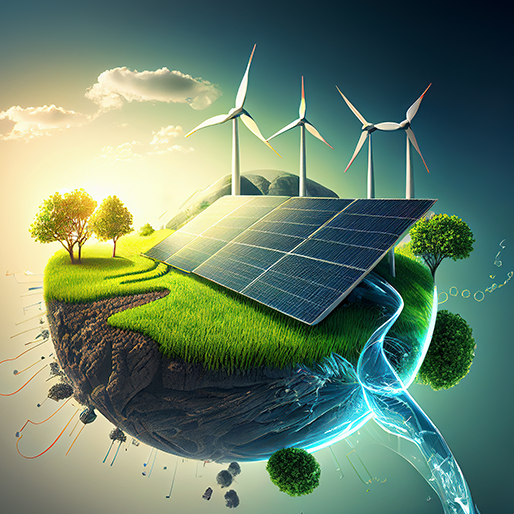In the face of escalating climate change and environmental degradation, the call for sustainable energy solutions has never been louder. As we stand at this critical juncture, the shift towards green energy solutions emerges not just as an alternative but as a necessity. Eco-energizing our world means adopting practices and technologies that utilize renewable resources, reducing our carbon footprint and paving the way for a brighter, cleaner future.
Why Green Energy Matters
Green energy, often interchangeably referred to as renewable energy, is derived from natural resources that are continually replenished. Unlike fossil fuels, which are finite and contribute significantly to greenhouse gas emissions, green energy sources like solar, wind, and hydroelectric power offer a cleaner and more sustainable alternative.
The importance of green energy extends beyond environmental benefits. By harnessing these renewable resources, we can reduce our dependence on non-renewable fossil fuels, which are subject to price volatility and geopolitical tensions. Green energy solutions also foster economic growth by creating jobs in the renewable energy sector and driving innovation.
Harnessing Solar Power
Solar energy is one of the most abundant and accessible green energy sources available to us. With advancements in technology, solar panels have become increasingly efficient and affordable, making it easier for households and businesses to harness the power of the sun.
Installing solar panels not only reduces electricity bills but also allows individuals to generate their own clean energy, contributing to a decentralized energy system. In addition to rooftop solar installations, large-scale solar farms are being developed to meet the growing demand for renewable energy.
The Power Of Wind Energy
Wind energy is another promising green energy solution that has gained traction in recent years. Wind turbines convert the kinetic energy of the wind into electricity, offering a scalable and cost-effective renewable energy source.
Countries with favorable wind conditions have invested heavily in wind energy infrastructure, harnessing this abundant resource to meet their energy needs. Offshore wind farms, in particular, have great potential as they can capture stronger and more consistent wind speeds compared to onshore installations.
Hydroelectric Power: Tapping Into Water Resources
Hydroelectric power harnesses the energy of flowing water to generate electricity. By constructing dams and reservoirs, we can control the flow of water and convert its energy into a usable form.
While hydroelectric power has been a significant source of renewable energy for decades, there are ongoing efforts to improve its efficiency and minimize environmental impact. New technologies and practices are being developed to ensure that hydroelectric projects are both sustainable and beneficial to local ecosystems.
Innovations In Green Energy Solutions
The transition to green energy is not without its challenges, but ongoing innovations and advancements in technology are paving the way for more efficient and reliable renewable energy sources. Energy storage solutions, such as batteries and pumped-storage hydroelectricity, are being developed to address the intermittent nature of solar and wind power, ensuring a stable supply of green energy.
Smart grid technologies are also playing a crucial role in the integration of renewable energy into our existing energy infrastructure. By optimizing energy distribution and consumption, smart grids enable more efficient use of renewable resources and reduce wastage.
The Role Of Policy And Investment
While technological advancements are crucial, the role of policy and investment cannot be overstated in accelerating the adoption of green energy solutions. Governments and businesses must collaborate to create a conducive environment for renewable energy development, offering incentives and subsidies to encourage investment in green technologies.
Public awareness and education are also key to driving the transition to green energy. By raising awareness about the benefits of renewable energy and the importance of sustainability, we can empower individuals and communities to make informed choices and support the shift towards a greener future.
Conclusion: Embracing A Sustainable Future
Eco-energizing our world requires a collective effort from all stakeholders – governments, businesses, and individuals alike. By harnessing the power of green energy solutions like solar, wind, and hydroelectric power, we can reduce our carbon footprint, mitigate the impacts of climate change, and pave the way for a sustainable future.
The transition to green energy is not just about adopting new technologies; it's about changing the way we think about energy consumption and embracing a more sustainable way of life. As we continue to innovate and invest in renewable energy sources, let us remember that the choices we make today will shape the world of tomorrow.
Frequently Asked Questions
What is green energy?
Green energy, also known as renewable energy, is derived from natural resources that are replenished naturally and quickly. These sources include solar, wind, hydroelectric, and geothermal energy. Unlike fossil fuels, green energy sources produce minimal greenhouse gas emissions and are considered environmentally friendly.
How does green energy benefit the environment?
Green energy solutions help reduce greenhouse gas emissions, which are major contributors to climate change. By transitioning to renewable energy sources, we can decrease our reliance on fossil fuels, conserve natural resources, and protect ecosystems from the harmful effects of pollution and environmental degradation.
Are green energy solutions cost-Effective?
While the initial investment for green energy technologies like solar panels or wind turbines can be higher, they often result in long-term savings on electricity bills. Additionally, as technology improves and production scales up, the cost of renewable energy continues to decrease, making it increasingly cost-effective compared to fossil fuels.
What are the most popular green energy sources?
The most popular green energy sources include solar energy, wind energy, and hydroelectric power. Solar energy involves capturing sunlight using photovoltaic cells, wind energy uses turbines to harness the power of the wind, and hydroelectric power utilizes flowing water to generate electricity.
How reliable are green energy sources?
Green energy sources like solar and wind can be intermittent, meaning their availability depends on factors like weather conditions and time of day. However, advancements in energy storage technologies and smart grid systems are improving the reliability and stability of renewable energy, making it a more viable option for meeting our energy needs.





Comments